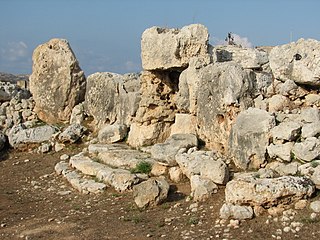
Ġgantija is a megalithic temple complex from the Neolithic era, on the Mediterranean island of Gozo in Malta. The Ġgantija temples are the earliest of the Megalithic Temples of Malta and are older than the pyramids of Egypt. Their makers erected the two Ġgantija temples during the Neolithic, which makes these temples more than 5500 years old and the world's second oldest existing manmade religious structures after Göbekli Tepe in present-day Turkey. Together with other similar structures, these have been designated a UNESCO World Heritage Site, the Megalithic Temples of Malta.

Tarxien is a town in the South Eastern Region of Malta. Its population stood at 8583 in March 2014.

Paola is a town in the South Eastern Region of Malta, with 8,706 inhabitants as of 2019. The town is a commercial centre in the Southern Harbour area of Malta, about 5 km from the capital Valletta, contiguous to Tarxien and Fgura, with which it forms a single urban area. Paola is named after Grand Master Antoine de Paule, who laid the foundation stone in 1626.

Gudja is a village in the Southern Region of Malta, with a population of 3,148 as of March 2017. The village is located on high grounds, south of Valletta. It is administered by the Gudja Local Council. A number of schools, clubs, public gardens and recreations places are found around the village.

The Hypogeum of Ħal Saflieni is a Neolithic subterranean structure dating to the Saflieni phase in Maltese prehistory, located in Paola, Malta. It is often simply referred to as the Hypogeum, literally meaning "underground" in Greek. The Hypogeum is thought to have been a sanctuary and necropolis, with the estimated remains of more than 7,000 people documented by archeologists, and is among the best preserved examples of the Maltese temple building culture that also produced the Megalithic Temples and Xagħra Stone Circle.

Ħaġar Qim is a megalithic temple complex found on the Mediterranean island of Malta, dating from the Ġgantija phase (3600–3200 BC). The Megalithic Temples of Malta are among the most ancient religious sites on Earth, described by the World Heritage Sites committee as "unique architectural masterpieces." In 1992 UNESCO recognized Ħaġar Qim and four other Maltese megalithic structures as World Heritage Sites. V. Gordon Childe, Professor of Prehistoric European Archeology and director of the Institute of Archaeology in the University of London from 1946-1957 visited Ħaġar Qim. He wrote, "I have been visiting the prehistoric ruins all round the Mediterranean, from Mesopotamia to Egypt, Greece and Switzerland, but I have nowhere seen a place as old as this one."

Mnajdra is a megalithic temple complex found on the southern coast of the Mediterranean island of Malta. Mnajdra is approximately 497 metres (544 yd) from the Ħaġar Qim megalithic complex. Mnajdra was built around the fourth millennium BCE; the Megalithic Temples of Malta are among the most ancient religious sites on Earth, described by the World Heritage Sites committee as "unique architectural masterpieces." In 1992 UNESCO recognized the Mnajdra complex and four other Maltese megalithic structures as UNESCO World Heritage Sites. In 2009 work was completed on a protective tent.

The Megalithic Temples of Malta are several prehistoric temples, some of which are UNESCO World Heritage Sites, built during three distinct periods approximately between 3600 BC and 2500 BC on the island country of Malta. They had been claimed as the oldest free-standing structures on Earth until the discovery of Göbekli Tepe in Turkey. Archaeologists believe that these megalithic complexes are the result of local innovations in a process of cultural evolution. This led to the building of several temples of the Ġgantija phase, culminating in the large Tarxien temple complex, which remained in use until 2500 BC. After this date, the temple-building culture disappeared.

The Skorba temples are megalithic remains on the northern edge of Żebbiegħ, in Malta, which have provided detailed and informative insight into the earliest periods of Malta's neolithic culture. The site was only excavated in the early 1960s, rather late in comparison to other megalithic sites, some of which had been studied since the early 19th century. The site's importance has led to its listing as a UNESCO World Heritage Site, a listing it shares with six other megalithic temples in Malta.

The Tarxien Temples are an archaeological complex in Tarxien, Malta. They date to approximately 3150 BC. The site was accepted as a UNESCO World Heritage Site in 1992 along with the other Megalithic temples on the island of Malta.

The Ta' Ħaġrat temples in Mġarr, Malta are recognized as a UNESCO World Heritage Site, along with several other Megalithic temples. They are amongst the world's oldest religious sites. The larger Ta' Ħaġrat temple dates from the Ġgantija phase ; the smaller is dated to the Saflieni phase.

Tas-Silġ is a rounded hilltop on the south-east coast of the island of Malta, overlooking Marsaxlokk Bay, and close to the town of Żejtun. Tas-Silġ is a major multi-period sanctuary site with archaeological remains covering four thousand years, from the neolithic to the ninth century AD. The site includes a megalithic temple complex dating from the early third millennium BC, to a Phoenician and Punic sanctuary dedicated to the goddess Astarte. During the Roman era, the site became an international religious complex dedicated to the goddess Juno, helped by its location along major maritime trading routes, with the site being mentioned by first-century BC orator Cicero.

Borġ in-Nadur is an archaeological site located in open fields overlooking St George's Bay, near Birżebbuġa, Malta. It is occupied by a Tarxien phase megalithic temple as well as the remains of a Bronze Age village which includes the earliest fortification in Malta. The site is located close to various Bronze Age cart ruts and silos, a Roman villa at Ta' Kaċċatura, as well as Saint George Redoubt which was built thousands of years later in 1715–1716.

Santa Verna is a megalithic site in Xagħra on the island of Gozo, Malta. The site was originally occupied by a village and a megalithic temple. Although the temple is in poor condition now, in ancient times it was probably one of the major temples in the Maltese islands. The site takes its name from a chapel dedicated to Saint Venera that once stood close to the temple.

Buġibba Temple is a megalithic temple on the border of Buġibba and Qawra towns, limits of St. Paul's Bay, Malta. A hotel was built on the grounds of the temple.

Xrobb l-Għaġin Temple is a ruined megalithic temple in Xrobb l-Għaġin, limits of Marsaxlokk, Malta. After being identified in 1913, the site was excavated between 1914 and 1915. It was believed to have been largely destroyed by coastal erosion later on in the century, but investigations carried out in 2015 revealed that the remains of the temple still survive, along with a previously unrecorded megalithic structure nearby.
The Kordin Temples are a group of megalithic temples on Corradino Heights in Paola, Malta. The temples were inhabited from pre-history, by Phoenicians and then by the Greeks and Roman periods. In the 17th century the site belonged to Giovanni Francesco Abela. He had excavated several sites in the whereabouts, and had his country residence in the area. He had originally planned to write his will to the Order, but eventually left his villa, that was used as Malta's first museum, known as Museo di San Giacomo, and the surrounding lands to the Jesuits. The land still belonged to the Jesuits, until their expulsion in the 18th century by the Order when all their land and property was taken by the treasury. The site was excavated during the Order of St. John on the order of Grand Master Manuel Pinto da Fonseca by archeologist Gio Antonio Barbaro. The temples were then extensively excavated by Sir Themistocles Zammit during the British period.
The Ħal Ġinwi temple was a prehistoric megalithic temple site located southeast of Żejtun, Malta dating back to the Ġgantija phase. The site is located in an area bearing the same name, or alternatively Ħal Ġilwi, which is known for its archaeological remains, and lies around one kilometre from the Tas-Silġ multi-period sanctuary and archaeological site.

The Golden Gate of the Ecliptic is an asterism in the constellation Taurus that has been known for several thousand years. The constellation is built by the two eye-catching open star clusters of the Pleiades and the Hyades that form the two posts of a virtual gate at the two sides of the ecliptic line.
The Ħal Resqun catacombs at Gudja, are interpreted as early Christian catacombs or paleochristian hypogea in Malta. The Ħal Resqun catacombs are especially notable for their carved decorations, and other features which are uncommon in Maltese catacombs, and of exceptional value. Some historians have suggested that, unlike other catacombs, those at Ħal Resqun portray enough Christian markers to be classified as paleochristian remains, while others view these features to be inconclusive. Some of the graffiti, interpreted by a number of historians as portraying a biblical scene, are thought to be unique in the world, and considered one of the most important remains from Late Antiquity in Malta.
























